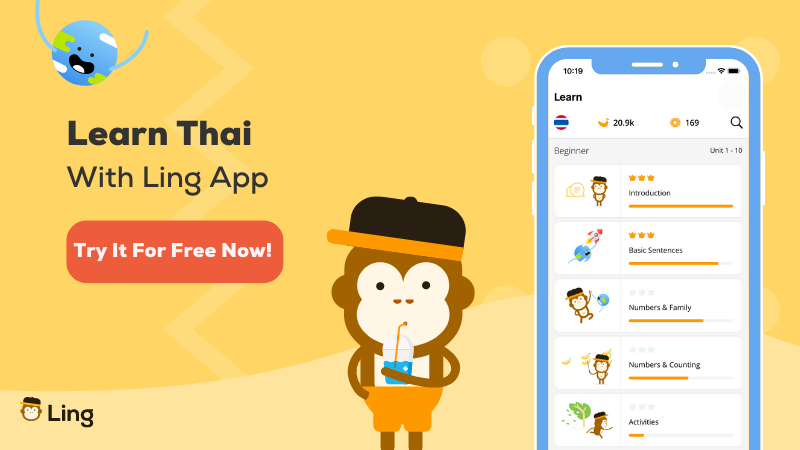How well do you know the history of the Thai language? Not much? A lot? When starting out, I didn’t know much at all. Of course, I had a basic understanding of language families and how Laos and Thai are closely related, but I wanted to dig deeper.
While this may not be particularly interesting for those looking to learn Thai for travel reasons, I am sure that it will capture the interest of those wanting to know more about Thai history. Ultimately, I hope that this insight will inspire some people to start learning Thai. Let’s not waste any time learning more about the rich culture and history of the Thai language!
What Exactly Is Thai Language?
You can learn a lot about a language through the history of the country it is spoken in. Likewise, its neighbors also play a huge role in the course the language takes. This is true for the Thai language.
Did you know that Thailand used to be called Siam? Yes, just like the Siam area in the capital, Bangkok. Thus, it makes sense that the Thai language was referred to as Siamese. This applies to the breed of cat and the name for conjoined twins, too.
This name remained (on and off at points) up until the year 1948 – which is the year 2491 in the Thai calendar. In case you were wondering, the name ‘Thailand’ actually means land of the free, with the word ‘Thai’ (ไทย) meaning free man.
For what it is worth, the name ‘siam’ (สยาม) is thought to have roots in the Pali, Sanskrit or Mon languages. By the way, these are languages you will be hearing about a lot.
The Tai-Kadai Language Family
When looking into the history of the Thai language, you will find that it belongs to a group of languages called the Tai-Kadai. This group of languages is distributed across Southern China, Laos, Myanmar, and, of course, Thailand.
To understand why this is the case, you will need to look at the history of the country and region as a whole. As you can imagine, the borders we know today are relatively recent. Going back thousands of years, before even the great kingdoms of Thailand and its neighboring countries emerged, there were tribes who shared a common language. This language is referred to as the Tai language.
From their initial home in the south of China, they traveled extensively across the Southeast Asian peninsula. As well as their culture, they brought with them their language. As these tribes started to settle down in this region, they mingled with tribes that were already located there.
Over time, these groups of tribes began to influence each other, both in their way of life and the language they spoke. The Tai language now started to change, and those located in different areas of the region had different influences on them, so they changed differently.

Thai Influencing Other Cultures
Thailand has had a long and interesting history. It wasn’t all pleasant, however. The area where Thailand is currently located was made up of several key kingdoms, with other notable opponents being located in areas of modern-day Myanmar, Cambodia, and China.
So, not only would the various kingdoms of Thailand in the North and South fight with each other, but these other kingdoms also joined in. The point is, it was these kingdoms and their spread that ultimately impacted the Thai language we know today.
The movement of people with every win and loss changed who occupied certain areas, bringing with them their own language. Over time, elements of the language would be adopted into Thai.
By the way, this Tai language was initially written using ancient Chinese characters. However, in the 13th century, this was changed. Instead, Tai would now be written in the Old Khmer script.
This leads to a number of different things. Tai people could now more easily communicate with Old Khmer-speaking people. Also, as the Old Khmer script had its own, long history, it ultimately changed the way Tai was spoken.
Vocabulary from Old Khmer, many of which had Sanskrit and Pali origins, made its way into Tai. The religion of the Khmer people was Buddhism, which is why many Indian/Buddhist words are used in the modern-day Thai language.
The History Of The Thai Language In Modern Day
Of course, the language didn’t just suddenly change overnight. It was over these thousands of years of change that the Tai language of before became what we describe today as Thai. First, it split into three different types: Northern, Central, and Southwestern Tai. Then, that Southwestern Tai group split once more, creating the Lao and Thai languages, alongside numerous smaller ones. There is another thing to consider too.
When talking about modern-day Thai, you should note that there are several varieties still used today. Sure, many people understand and speak the standard Thai variety. However, certain regions of Thailand have their own dialect of the Thai language.
When talking about ‘standard Thai’, we are referring to the dialect of Central Thailand as is spoken in the capital. However, the famous Isan dialect of Northeast Thailand is also prominent. While still being Thai, it shares many elements with Lao, including some unique vocabulary and grammar.
Otherwise, there are the Northern and Southern Thai dialects that have some differences from the standard Thai spoken throughout the country.

Examples Of Influence In Thai
These days, it is still quite easy to see the influence of both older languages and even today’s languages in Thai. Didn’t I say that the history of the Thai language will come into play when learning Thai?
If you are already familiar with the many Thai characters, you will know that the consonants of ฃ and ฅ are no longer widely used. In fact, some sources say that they are not used in any Thai words. So what is the story behind that?
Supposedly, when creating the first typewriter for the Thai script, there wasn’t enough space for all the characters. They ended dropping these two characters. But why these two? It turns out that they are the only two that do not correspond to letters of the Pali or Sanskrit alphabet.
Isn’t it interesting how history comes into play in the modern language? Let’s look at another example of the influence of history.
The Thai word for the basin is ‘ang’ (อ่าง), while in Middle Chinese, money was referred to as ‘ang’ (盎). This is just one example, but there are thousands of loan words in Thai from ancient sources like Old Chinese, Sanskrit, Pali, Mon, and Old Khmer. More recently, the English language has made its mark in the Thai language, too.
And Now You Know Some Thai History
Was that interesting? It certainly was for me to research. As long as I help inspire someone to learn Thai, then I consider it a job well done. Otherwise, I do think having knowledge of the history of the Thai language does in a way help with the learning process. Whether just a case of getting interested or learning the roots of the vocabulary, there is something good being achieved.

Learn More Thai Vocabulary And Its Language With The Ling App
Now you know its history, it’s time to learn the grammar, vocabulary, and more. Try the Ling app for free and see why it is the app of choice for thousands of language learners worldwide. It’s filled with 200+ language lessons that consist of reading, writing, speaking, and listening exercises. The fun doesn’t stop there! You can even browse other languages than Thai with the rest of the 60+ languages found in the Ling app.
Now, it’s your turn to learn the amazing Thai language by downloading the app on the Play Store or App Store to see how you’ll enjoy it more. In fact, you can even learn Thai while you’re on vacation, at school, or even learning by yourself. Why not start your plan to be fluent in Thai now?



















